Jig Fishing
There Is No Better Technique To Catch Big Bass
Jig fishing catches big bass but fishing jigs "properly" is a difficult skill to master. The technique demands diligent focus and a delicate touch. These may be two reasons recreational fishermen shy away from fishing jigs.
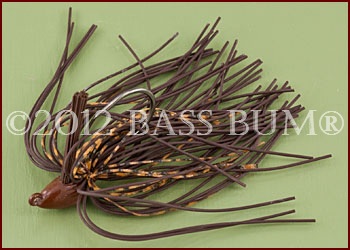
Jigs are not normally a lure you would turn to for fishing open water and clean bottoms. It's most effective when you're fishing some form of cover or structure. Rock bottoms, wood or brush, sunken tree tops, thick weeds or any type of heavy cover is where you fish jigs because jigs are really cover specific. Many anglers avoid these areas like the plague even though this is also where you will find the bigger bass.
Jig lure are not search baits as they are fished much to slow for this. A jig lure is a presentation lure. It is quite often a close contact lure. When bass fishing jigs you're often up close and personal with the bass looking the sucker in the eye, especially if you're flipping in shallow water where you're at a distance of no more than 15´ from your target.
Drop Speed and Lure Awareness - Keys To Successful Jig Fishing For Bass
Drop Speed
The drop speed of a jig plays a big role in the number of strikes you get when jig fishing. Most strikes will occur on the drop so it is important the jig sinks slowly staying in view and attracting attention as long as possible, especially in cold water.
So what influences "drop speed"?
The first factor is of course the actual weight of the lead head. Learning to use the correct weight is crucial in learning to fish jigs correctly because the weight contributes to the rate of fall. The lighter the jig, the slower the fall and the heavier it is the faster it falls. Pretty fundamental concept, right?
Generally speaking jigs in the 1/8- to 1/2-ounce range are good for laydown trees or brush in shallow water less than 10´ deep. If you're in water between 10-20´ deep and targeting standing trees or brush piles a 3/8-ounce is effective and anything deeper calls for a 1/2- to 3/4-ounce jig. Should you be fishing heavy weeds or grass your jig lures should be 3/4- to over 1 ounce so they can pass through the vegetation canopy to the bass underneath.
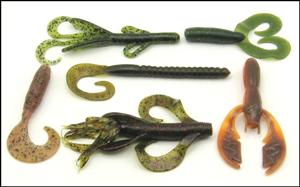
However, the rate of fall can be altered by the line size used and the size and shape of any trailer added to the jig. The more water resistance created by the trailer the more the fall rate is reduced.
Long thin trailers, like the worm shown at right, won't slow fall rate as much as craws and creature baits, which have more bulk and create more water resistance.
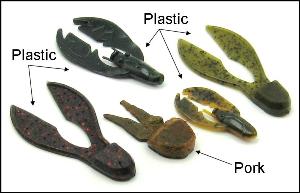
What's best for jig fishing, plastic or pork trailers? That is the question among many anglers as each has it's pro's and con's. The prevailing wisdom seems to be pork when water temperature is under 60° and plastic in water warmer than 60°. The feeling is that plastic stiffens in cold water while pork stays soft. With the softness of many of today's plastics I'm not sure this is as relevant as it may have been in the past.
I find Pork to be messy but it is certainly "meat" with a "real" feel and taste and perhaps is more likely to be held by a bass a bit longer than plastic. It will stay on the hook longer as it isn't as susceptible to tearing as plastic. Some will argue it's more lifelike in its action, though I disagree.
Plastic, especially today's plastics, are soft, lifelike, and available in sizes, shapes and colors enough to boggle the mind. For a junk fisherman and student of the sport like me, they provide an almost endless opportunity to experiment and broaden the spectrum of jig and trailer combination's that will catch bass in different situations. For me, it's just another part of "fishing" that brings enjoyment.

Lure Awareness
Line watching should be practiced when jig fishing. Why? Because many strikes on bass jigs are almost undetectable, really mere pick-ups that have no "tell" up the line to the angler. You will also recall from the section on "bass taste" in this site that a bass can inhale and spit out a lure in the blink of an eye. It doesn't take them long to "look at a horse shoe" to quote from an old joke.
So, regardless of whether your jig fishing involves flipping, pitching a jig to shallow cover or casting to deep structure, if you see your line jump, twitch or move to one side or the other, lower your rod tip, reel up slack and swing on it. If you hesitate you may be setting the hook in empty water.
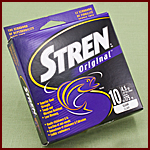 |
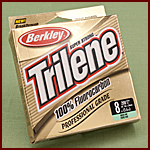 |
I use 10lb Stren Original clear blue fluorescent line for jig fishing. It is quite visible above the water and aides greatly in my seeing what's happening with my line. I also use 10lb Berkley Vanish Transition which is a fluorocarbon line that is a very visible gold color above the water and easy to see.
Weighing the line is also a part of lure awareness when jig fishing. What is it? It is knowing what your jig feels like when being worked and there is no fish on it. Any change, heavier or lighter, calls for a swing on it to set the hook. Swings are free remember.
Don't forget water temperature. If you're in water under 60° you should fish your jig slow. Barely move it along with long pauses. If water temperature is above that then give it more action by repeatedly hopping it up and creating multiple "falls as it floats back to the bottom.

When And Where To Fish Jigs
Seasonal Considerations
Spring, especially pre-spawn, is when jig fishing is probably the best and when it is often overlooked. Bass are feeding on crawfish this time of year so jig lures which mimic crawfish are particularly appealing.
Depending on what part of the country you're in, migration from deep to shallow water begins when the temperature reaches upper 40's in the North and mid 50's in the South. However, there are no hard and fast rules for when they begin to move.
During this transitional period bass will "stage" prior to moving toward their spawning areas. So they will be found between their deep winter haunts and shallow spawning sites. Staging areas tend to be structure oriented so focus on areas where bluffs transition into chunk rock and gravel bottoms on main lake points. Points that are 15´ to 20´ deep sprinkled with stumps next to a drop off are ideal staging areas. Humps and ridges are also good on some lakes while depressions and large flats on others. You'll have to determine where and how deep these staging areas are where you're fishing as they differ from lake to lake.
In natural northern lakes bass will "stage" around inside weed edges more than points. Inside turns with weeds on the outer edge and soft sand on the inside edge are key northern staging areas.
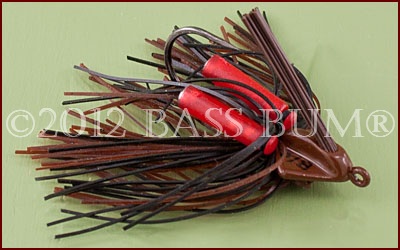
As the water continues to warm they will move to secondary points and creeks. If you find weeds on hard bottom here that are submerged 5´- 12´ you might try swimming a 1/4 ounce or 3/8 ounce lead jig just above them. A trailer of Uncle Josh #1 pork will help keep the jig "up" in the water. Keep your rod at about 10:00 and try to make your jig tick the top of the weeds. Make the jig "undulate" as you retrieve it.
What about that word, "undulate"? It means to move with a sinuous, wavelike rising and falling movement. Makes your mind wander doesn't it? Oh, but I digress.
Alternatively, fish the edges of any weeds you locate, say 20´ to 25´ deep. A 1/2 ounce jig is a good choice here. I suggest including rattles and multiple hops, which translates into multiple falls. There are others who feel very little action is better in this situation. Try both and see what your results are.
Late Spring finds bass on bed. Though jig lures can be flipped
to beds, tubes are far better for this, especially when fishing for
smallmouth. There is much controversy surrounding "sight fishing" beds.
I choose to not disturb bass on bed. It's just my personal choice. I'm not saying it's good or bad. It's just that bass have enough problems from all the other forces in nature that interfere with the spawn without we fishermen adding to the problem. Remember, we want this great sport to continue so I choose personally to give them a break by leaving them alone when they're on bed.
Summer is also prime jig fishing season though most anglers will opt for crankbaits and worms. Jigs can be successfully fished day and night in summer.
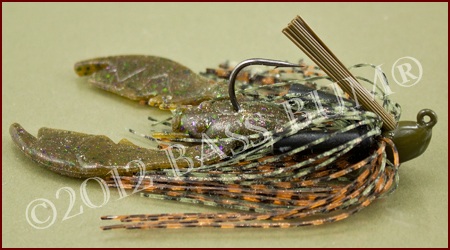
Milfoil, hydrilla and coontail have grown tall and wide and bass will be found in and under its canopy. A 3/4 to 1 ounce "grass jig" will punch through the grass and not readily pick up grass on the retrieve. Strikes may come on the fall while you're letting the jig fall through to the bottom. If you're not bit on the way down, once on the bottom hop it a few times before pulling out. Most grass jigs will have rattles. Don't overlook shallow cover like brush and laydowns in summer.
Jig lures can be effective fishing deep structure (12-15´) in summer. With a good map and/or your depth finder look for structure on the edge of a channel drop off as bass will often hold on such spots. After casting a rattle equipped jig to the target and controlling the jig's fall to the bottom, use a hop retrieve technique. It is best to not let your jig fall on uncontrolled slack line as you will likely have strikes go unnoticed.
Also look for bass on main lake points, break lines, humps and roadbeds to fish jigs. Current moving around bridge supports and creek mouths should be probed by jig fishing as well. If you're fishing rivers look for current as that is where oxygen is concentrated.
Fall is a great time for jig fishing around logs, stumps, laydowns and any other type wood. Swimming a 3/8 ounce white jig around such cover can be very effective. Target boat docks with both regular and swim jigs this time of year too.
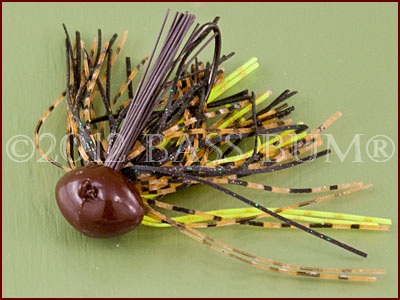
Many bass will move up to main lake structure in fall following baitfish. In reservoirs with rocky bottoms and rock strewn points a 3/8 to 3/4 ounce football jig pulled along the bottom will catch bass this time of year.
When the weeds die back in the fall bass will relate to the "outside" edge of hydrilla beds and a 1/2 to 1 ounce jig works well there.
Winter is when bass, especially largemouth, move deep to await spring. When you think jig fishing think deep water structure and cover and a slow, slower, even slower, slow till it hurts, retrieve. Sounds like great fun in temperatures between 35° to 45° doesn't it? Well it is. Jig fishing in the dead of winter is when you can land some of the largest bass. Why you ask? There is less fishing pressure and the largest bass are opportunistic and dominant so are more likely to be the first to an easy, available meal.
There really is no reason to "freeze" while winter fishing. Today you can find all kinds of outstanding cold weather clothing made from high-tech materials that will keep you comfortable head to foot on the water. So don't use the cold weather as an excuse to pass up a time when you can catch some hawgs.
Paralleling a "bluff" with finesse jigs from 3/16 to 3/8 ounce with pork trailers in winter often finds bass suspended 5-10´ down hugging the bluff. A slow falling jig often catches these guys. The jigs at right are from left to right 1/16, 1/8 and 3/16 ounce in weight.
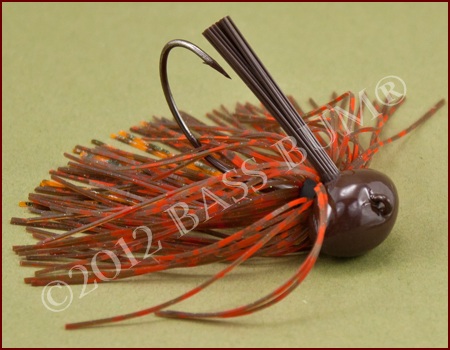
Find "channels" in reservoirs, that is, any creek or river channel that was there prior to the filling of the lake, and look for bass to be located in turns or bends of this type structure. If these are adjacent to flats, especially shoreline flats, more the better. But bass can be holding at any level on the channel walls. They can be on the flats, at the edge of the drop, half way down or even where the drop bottoms out. I start at the bottom (could be 30´ to 40´ deep) by making a long cast and letting the jig, usually a 1/2 or 3/4 ounce football jig, sink to the bottom on controlled slack. If not hit on the fall, once there I let it sit for a while then "slowly" drag it up the drop wall. This retrieve targets bass holding close to the bottom, not those that may be suspended.

Thoughts On Rods, Reels And Line For Jig Fishing
A good all around rod for jig fishing is a 7´ to 7 1/2´ medium to medium heavy action rod with a fast tip which will allow you to flip, pitch and cast a jig in most instances. Now if you're fishing with very light, finesse jigs perhaps only a medium action is better and if you're flipping very heavy, gnarly cover a regular, stiff "flippin stick" is the better choice.
As for reels, both baitcasters and spinning reels are used in jig fishing for bass. I use both and many other anglers do as well. If you're after largemouth in heavy cover a baitcaster is a good choice. If smallmouth are your target and you're using smaller finesse or hair jigs a spinning outfit works just fine. However, don't think for a minute that a smallmouth, especially the big ones we're all after, won't hit a big, heavy jig designed to catch largemouth.
What about line? Monofilament that is 10-12lbs is going to work in most situations though heavy cover or deep structure calls for line as heavy as 20lbs. I use monofilament and fluorocarbon most often as both have some stretch, yes, fluorocarbon does stretch despite what some say, and both are stiff enough to reflect twitches and telegraph a strike up the line. Braid on the other hand is very limp and, for me at least, fails to give me a sense of confidence that I will feel or even see when a bass "takes" my jig.
Just as a point of reference I use the following rigs for various jig fishing situations.
All Star, 7´ 6", heavy, fast flipping stick with a Shimano Castaic baitcasting reel filled with 20lb fluorocarbon line.
G. Loomis, 7´ 4", medium, fast, spinning rod with a Shimano Stella 4000FA spinning reel with 10lb monofilament or fluorocarbon line
G. Loomis, 7´ 7", medium-heavy, fast, spinning rod with a Shimano 4000FB spinning reel filled with 12lb monofilament or fluorocarbon line
Anatomy Of A Jig. More Than Meets The Eye
Fishing Jigs In Depth
Return to Bass Fishing Techniques from Jig Fishing
